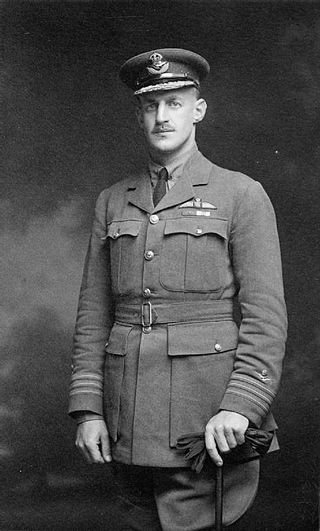Related Research Articles

Lanoe George Hawker, was a British flying ace of the First World War. Having seven credited victories, he was the third pilot to receive the Victoria Cross, the highest decoration for gallantry awarded to British and Commonwealth servicemen.

World War I was the first major conflict involving the large-scale use of aircraft. Tethered observation balloons had already been employed in several wars, and would be used extensively for artillery spotting. Germany employed Zeppelins for reconnaissance over the North Sea and Baltic and also for strategic bombing raids over Britain and the Eastern Front.

The Airco DH.2 was a single-seat pusher biplane fighter aircraft which operated during the First World War. It was the second pusher design by aeronautical engineer Geoffrey de Havilland for Airco, based on his earlier DH.1 two-seater.

Between 1911 and 1914, the Royal Aircraft Factory used the F.E.2 designation for three quite different aircraft that shared only a common "Farman" pusher biplane layout.

Group Captain Lionel Wilmot Brabazon Rees, was a Welsh aviator, flying ace, and a recipient of the Victoria Cross, the highest award for gallantry in the face of the enemy that can be awarded to British and Commonwealth forces. He was credited with eight confirmed aerial victories, comprising one enemy aircraft captured, one destroyed, one "forced to land" and five "driven down". Rees and his gunner, Flight Sergeant James McKinley Hargreaves, were the only two airmen to become aces flying the earliest purpose-built British fighter aeroplane, the Vickers Gunbus.

The Vickers F.B.5 was a British two-seat pusher military biplane of the First World War. Armed with a single .303 in (7.7 mm) Lewis gun operated by the observer in the front of the nacelle, it was the first aircraft purpose-built for air-to-air combat to see service, making it the world's first operational fighter aircraft.
Group Captain Geoffrey Hilton "Beery" Bowman, was a British First World War fighter ace credited with 32 victories. After attaining the rank of major in the Royal Flying Corps, he later became a group captain in the Royal Air Force.
Captain Frederick James Harry Thayre was a British two-seater flying ace in World War I who, in conjunction with his observer-gunners, was credited with twenty aerial victories.
Captain Guy Patrick Spence Reid was a British World War I flying ace credited with five aerial victories.
Sidney Edward Cowan MC & Two Bars was an Irish World War I flying ace credited with seven aerial victories.
Major Stephen William Price was a British World War I flying ace credited with seven aerial victories.
Squadron Leader David Mary Tidmarsh was an Irish-born flying ace of the Royal Flying Corps during the First World War, credited with seven aerial victories.
Captain Alexander Roulstone was a British World War I flying ace credited with eight aerial victories. He scored his victories, and downed two German aces, while handicapped by flying bombers.
Major John Bowley Quested was a First World War flying ace from England. He was credited with eight aerial victories, the most notable of which was over Gustav Leffers.
Flight Lieutenant David Arthur Stewart, was a British First World War flying ace credited with sixteen aerial victories. Remarkably, they were all scored while he was flying bombers instead of fighters.
Captain Arthur Gerald Knight was a British World War I flying ace credited with eight aerial victories. He was under attack by Oswald Boelcke and Erwin Böhme when they collided, causing Boelcke's death. Two months later, Knight would fall under the guns of Manfred von Richthofen, who had also been in the dogfight when Boelcke was killed.
Wing Commander Selden Herbert Long, was an English flying ace during the First World War. He was credited with nine confirmed aerial victories. He was also noted for the audacity of his trench strafing missions–an early form of close air support.
Captain Edwin Louis Benbow was an English flying ace during the First World War, credited with eight victories, comprising six destroyed and one shared destroyed, and one 'out of control'. He was the only pilot to gain 'ace' status flying the Royal Aircraft Factory F.E.8 exclusively.
Captain Lancelot Lytton Richardson was an Australian flying ace during World War I. He was credited with seven confirmed aerial victories before his death in action on 13 April 1917.
Flight Commander Guy William Price was an Irish Royal Naval Air Service flying ace during World War I, having 12 confirmed aerial victories. He was awarded the Distinguished Service Cross twice within a 22-day period.
References
- Citations
- ↑ Guttman & Dempsey (2009), pp.18–19.
- ↑ "Royal Flying Corps: 1914 Roll". Graces Guide. 2014. Retrieved 6 March 2015.
- 1 2 "James McKinley Hargreaves". The Aerodrome. 2015. Retrieved 6 March 2015.
- ↑ "No. 29369". The London Gazette (Supplement). 16 November 1915. pp. 11420–11421.
- ↑ "No. 29344". The London Gazette (Supplement). 29 October 1915. p. 10731.
- ↑ Guttman & Dempsey (2009), p.19.
- ↑ "Aviators' Certificates". Flight . VII (356): 806. 22 October 1915. Retrieved 6 March 2015.
- Bibliography
- Guttman, Jon & Dempsey, Harry (2009). Pusher Aces of World War I. Osprey Publishing. ISBN 978-1-84603-417-6.